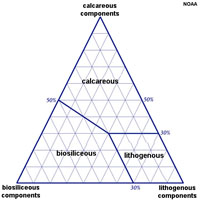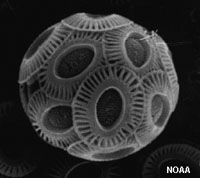How Do Calcareous Oozes Form
6.20: Oozes
- Folio ID
- 10238
Oozes
The oceans are full of many varieties of microscopic organisms, but but several varieties are responsible for generating vast quantities of biogenous sediments. Ooze
- Oozes tin can exist dominantly calcareous or siliceous in composition.
- To be considered an "ooze" sediment must consist of >30% biogenous material (Effigy half-dozen.77).
- Oozes grade slowly - accumulating at a rate of i/2 to 2 1/2 inch per k yrs.
- Oozes course in low energy environments and are very fine grained (clay sized particles).

Calcareous oozes
Calcareous oozes are sediments dominantly composed dominantly of calcium carbonate (CaCOthree). Ii dominant groups of microorganisms that contribute carbonate remains: Coccolithopores (phytoplankton) and Foraminifera (zooplankton)
Coccolithopores
Coccolithopores are unmarried-celled marine phytoplankton (microscopic plants) that live in large numbers throughout the upper layers of the ocean. Unlike any other plant in the ocean, coccolithopores secrete shells of microscopic plates fabricated of calcite (CaCOiii). These scales, known as coccoliths, are shaped like hubcaps and are only iii one-thousandths of a millimeter in diameter (Figure vi.78). Coccolithopores are part of base of the food chain and contribute vast quantities of coccoliths every bit sediment to large regions of the body of water basins. Coccoliths are full-bodied in calcareous ooze.
Coccoliths outset appear in the fossil tape in Triassic fourth dimension. Because they are composed of low-magnesium calcite (the most stable form) they are easily fossilized and preserved in sedimentary rocks. What is a Coccolithopores? (NASA)

Foraminifera (Forams)
Foraminifera (or forams) are a large group of unmarried-celled zooplankton, most species have calcareous shells (or tests). Their shells are usually divided into chambers which are added during growth and form patterns including spirals, open up tubes, or hollow spheres (Figure half-dozen.79). Depending on the species, the beat out may exist fabricated of crystalline calcite, organic compounds, or sand grains and other particles cemented together. They are usually less than 1 mm in size, but some species abound much larger, reaching up to 20 cm. The bulk of foraminifera species are benthic (pregnant they live on or within the seafloor sediment) while typically smaller varieties are floaters (planktonic) in the water cavalcade at various depths. Foraminifera are found in all depths of the body of water, although deep ocean varieties practice not have calcareous tests. They contribute a significant book of sediments to carbonate reefs and a major component of carbonate oozes throughout ocean basins.
Over 10,000 species are recognized, both living and fossil. They start appeared in the fossil record in Cambrian fourth dimension.
How Do Calcareous Oozes Form,
Source: https://geo.libretexts.org/Bookshelves/Oceanography/Oceanography_101_(Miracosta)/06%3A_Marine_Sediments/6.20%3A_Oozes
Posted by: allenthwary.blogspot.com


0 Response to "How Do Calcareous Oozes Form"
Post a Comment